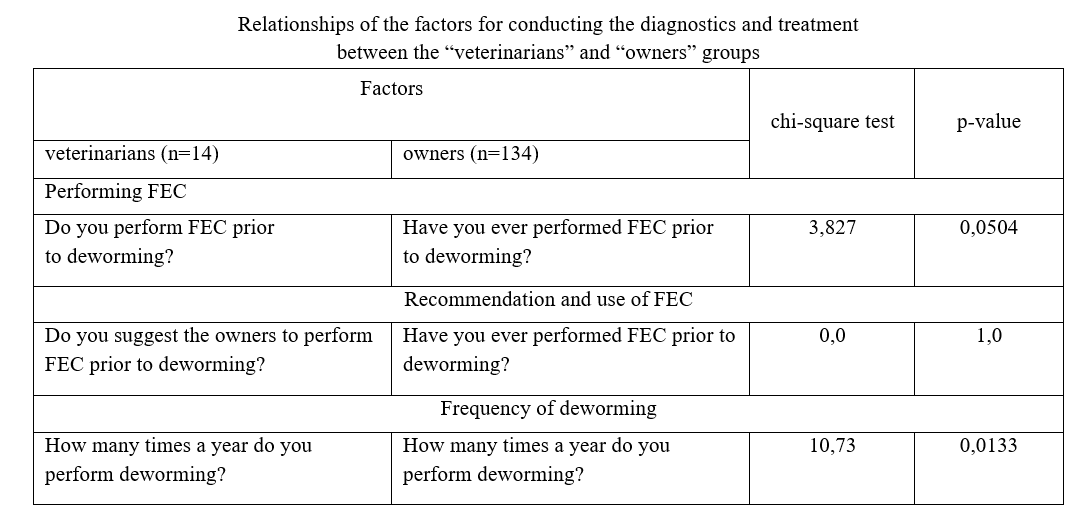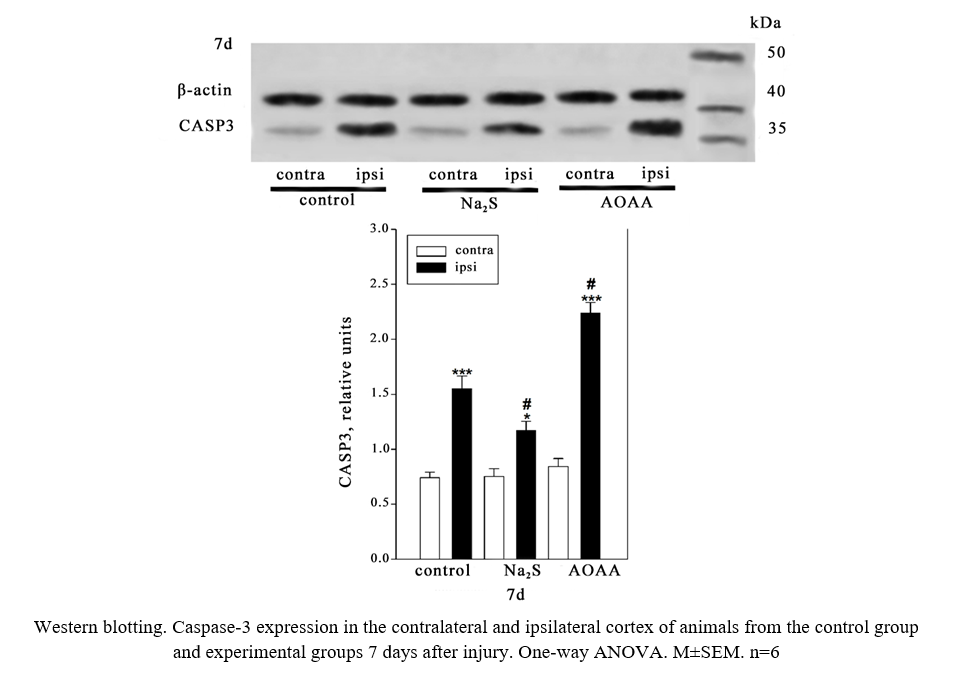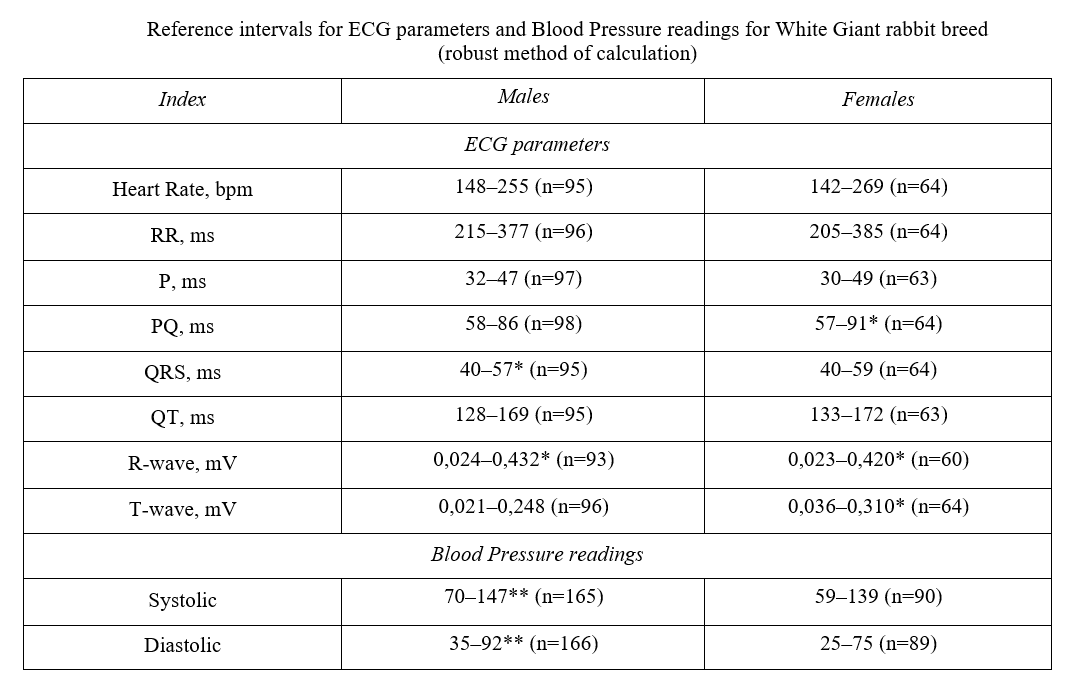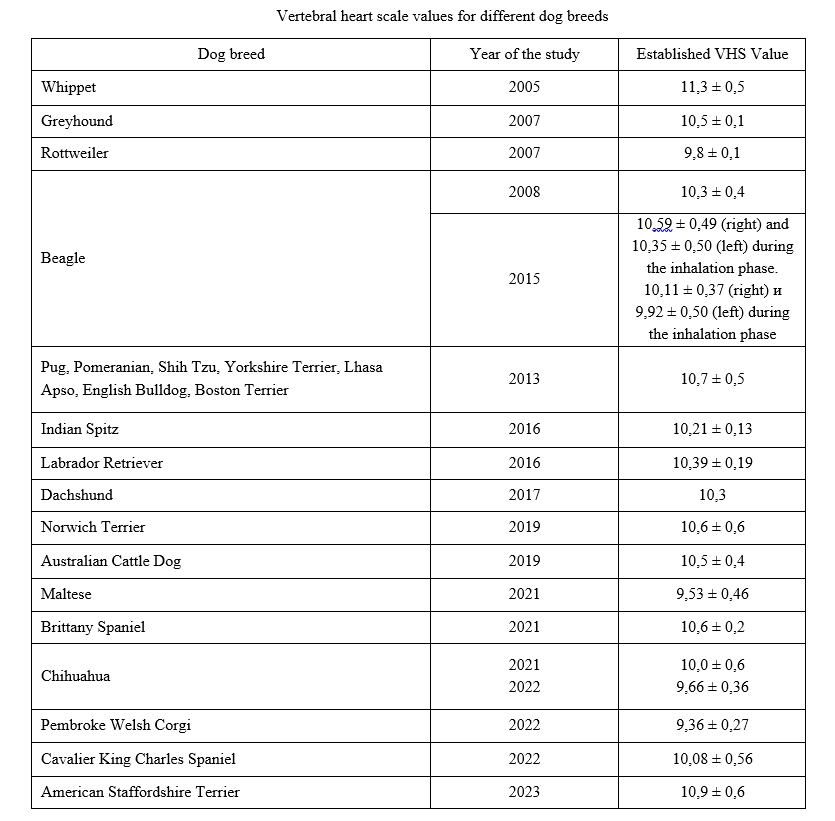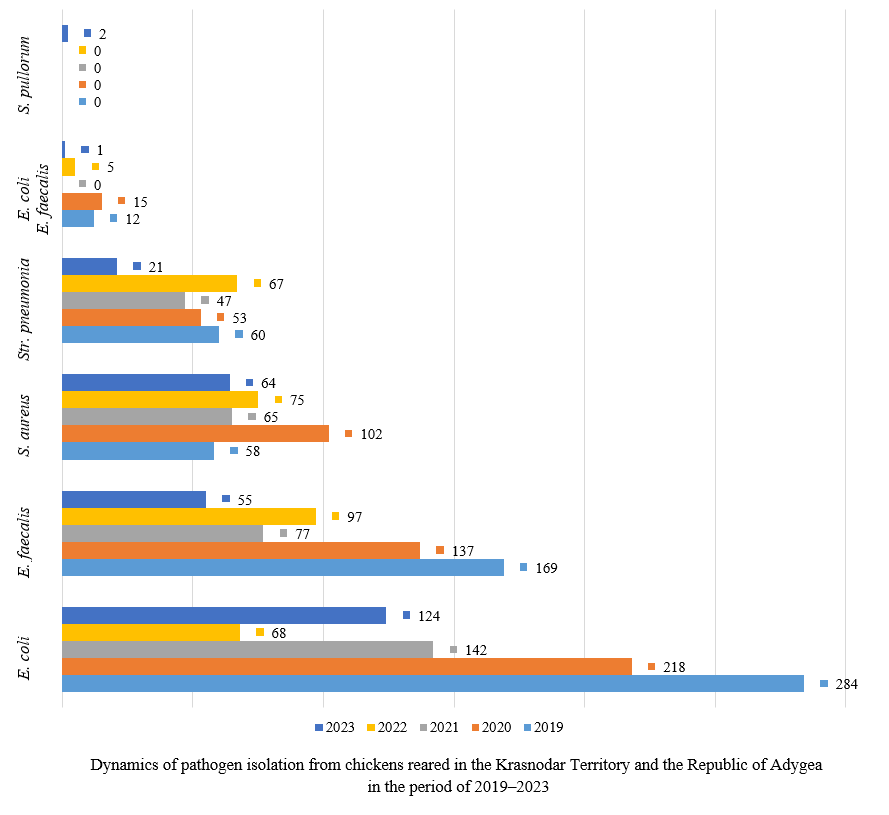PARASITOLOGY
The study evaluated the methods of horse deworming and degree of awareness of anthelmintic resistance problem. The results showed poor use of diagnostic FEC tests prior to deworming despite high awareness of the problem. A significant proportion of owners use visual assessment of horse weight to calculate drug dosages. It is important to improve communication between veterinarians and owners to implement the science-based strategies of helminth control. The need to enhance the approaches to prophylaxis and rational use of anthelmintics is highlighted.
Introduction. Equine helminthiasis, especially in the context of parasite resistance growth, remains an acute issue in the veterinary practices. In Russia, despite the availability of international guidelines, there are still no enough data on the parasite control measures really taken by the veterinary specialists and animal owners. The present pilot study aims at evaluating the level of awareness of horse owners and veterinary specialists about the advanced methods of combating helminth infections, as well as at analysing approaches to deworming and determining the possibility of using targeted treatment strategies in the Far East Region. The main objective is to identify the contradictions between the existing practices and scientific recommendations on prevention of anthelmintic resistance.
Materials and Methods. The study was conducted in September–October 2024 and was based on a questionnaire survey held among horse owners and veterinary specialists in the Far East Region of Russia. Several owners from other regions were interviewed to compare deworming practices. In total, 148 people participated in the survey. Online questionnaires and individual interviews were used to collect data. Questionnaires included the questions about frequency and methods of deworming, the use of diagnostic tests, knowledge about resistance and sources of getting information. To identify statistical relationships, the data were processed using the methods of descriptive statistics, chi-square tests and logistic regression.
Results. In the frame of the study, it was found that in the Far East the methods of interval deworming of horses were the most popular among the horse owners and veterinarians. Respondents were highly aware of the problem of anthelmintic resistance (73.13% among the owners and 78.57% among the veterinarians), but only 17.56% of the owners used the Faecal Egg Count (FEC) prior to deworming. Frequent consultations provided by the veterinarians did not much help to persuade the owners to implement the diagnostic tests or adhere to the quarantine measures. 72.39% of owners and 75% of veterinarians preferred using the macrocyclic lactones, which could exacerbate the risk of anthelmintic resistance development. However, the use of the anthelmintics rotation practices by the majority of owners (82.14%) and veterinarians (71.43%) makes it possible to feel optimistic. Logistic regression has revealed that knowledge on parasitic diseases has a positive effect on the use of FECs.
Discussion and Conclusion. The pilot study revealed the gaps between the knowledge on helminth control methods and their practical implementation. The majority of owners and veterinarians are aware of the problem of anthelmintic resistance, however diagnostic testing remains insufficient. To efficiently combat parasites, it is necessary to increase the quality of consultation services and implement the targeted deworming practices based on diagnostic tests.
ANIMAL PATHOLOGY, MORPHOLOGY, PHYSIOLOGY, PHARMACOLOGY AND TOXICOLOGY
The present study is the first one to demonstrate the effect of hydrogen sulfide on caspase-3 in traumatic brain injury. The chemical compound H₂S reduced the level of caspase-3, thus, affected the neuroinflammatory response. An experiment with an inhibitor of H₂S synthesis, AOAA, showed an inverse increase in the expression of this enzyme. The results confirm the importance of H₂S in the regulation of apoptotic cell death in the brain after injury. The study opens up prospects for the development of new neuroprotective agents.
Introduction. Traumatic brain injury (TBI) is a neurotrauma widespread in animals. TBI causes a complex cascade of pathological processes: primary brain injury turns into secondary brain injury associated with inflammation, oxidative stress, excitotoxicity and apoptosis. Secondary injury aggravates the condition after injury. In this regard, the role of hydrogen sulfide (H₂S) as a gasotransmitter involved in neuromodulation, anti-inflammatory, antioxidant and anti-apoptotic processes in the central nervous system is of particular interest. Caspase-3 is an important element in TBI-induced apoptosis. H₂S has a potential to modulate the expression and activity of caspase-3 affecting the survival of nerve cells and brain recovery after TBI. However, H₂S-dependent mechanisms of caspase-3 regulation in traumatic injury are not fully investigated. The aim of the research is to study the role of H₂S in the expression and localization of caspase-3 in neurons and astrocytes of mice with TBI.
Materials and Methods. The research was conducted at the Bioengineering Department of DSTU (Rostov-on-Don) from April 20 to June 1, 2024 in conditions compliant with the international and national standards. The objects of the study were 36 adult male mice divided into three groups: control group and two experimental ones. TBI was simulated by dropping a weight (200 g) on the intact skulls of mice anesthetized with chloral hydrate. During 7 days after the TBI, the animals were daily administered the sodium sulfide (Na₂S), a donor of H₂S, which can efficiently release H₂S, or the aminooxyacetic acid (AOAA), an inhibitor of cystathionine β-synthase (CBS), an enzyme responsible for the endogenous synthesis of H₂S, until the animals were withdrawn from the experiment. The use of Na₂S and AOAA enabled efficient modulation of the level of endogenous H₂S in the brain. The control group was administered physiological saline solution. Brain sections fixed in 4% paraformaldehyde (PFA) solution were incubated with antibodies to caspase-3 and to the neuronal nuclear antigen (NeuN) or to the astrocytic marker (GFAP). Colocalization was assessed using the ImageJ software. Caspase-3 expression in the brain penumbra was analysed by Western blotting using primary antibodies against caspase-3 and β-actin and secondary antibodies IgG conjugated to horseradish peroxidase. For detection, the chemiluminescence method was used.
Results. The initial level of caspase-3 in the brain cells of mice under study was low. Seven days after injury, TBI had induced caspase-3 expression in neurons and glial cells of the ipsilateral injured hemisphere in animals of all groups. Administering the donor Na₂S led to decrease of caspase-3 level in neurons by 32%, whereas administering the inhibitor AOAA led to its increase by 31% compared to the injured nerve cells of animals from the control group, which were administered the physiological saline solution. This was confirmed by the values of the M1 colocalization coefficient demonstrating colocalization of caspase-3-positive cells with the neuronal nuclear antigen (NeuN). Similar effects were demonstrated in astrocytes, which were visualized using the astrocyte-specific marker GFAP. Western blot analysis confirmed these data and showed a significant decrease of caspase-3 level with administering Na₂S and its increase with that of AOAA 7 days after TBI.
Discussion and Conclusion. The results of the study demonstrate that TBI leads to significant activation of caspase-3 in neurons and astrocytes of the injured hemisphere of mice brain, which means development of apoptosis in response to traumatic injury. Administering Na₂S has efficiently decreased caspase-3 level, which indicates its neuroprotective and anti-apoptotic effect. Whereas, administering the AOAA has induced an increase in caspase-3 expression, which confirms the important role of CBS and, therefore, of H₂S in regulation of cell death after TBI. The reliability of these findings was ascertained by both immunohistochemical and Western blot analysis. The obtained data contribute to better understanding the fundamental H₂S-dependent signaling mechanisms of survival and death of neurons and glial cells during traumatic injury of the nervous system. The CBS inhibitor and H₂S donor used in our study may serve a basis for development of the clinically efficient neuroprotective agents.
The study determines the reference intervals for ECG and BP in laboratory rabbits of various breeds. The data obtained confirm the similarity of the electrophysiological characteristics of rabbits with those of humans. The described ECG features are important for accurate interpretation of studies on rabbits. The results will significantly improve the assessment of cardiotoxicity of drugs in preclinical trials.
Introduction. Rabbits, ferrets, dogs, miniature pigs and monkeys are considered to be the preferable test systems for assessing the efficacy of the developed medicinal products for the cardiovascular system. The heart rate and distribution of cardiac ion channels in the heart of these species is similar to that in the human heart. The present work focuses on rabbits as they are one of the most widely used species in preclinical research, however, the results of measurements carried out on a sufficient sample of intact animals can hardly be found in the open sources. Thus, the aim of the study is to determine the features of the electrocardiogram and to establish the reference intervals of the key cardiovascular indices as well as of the blood pressure in the sexually mature laboratory rabbits of different breeds, ages and sexes, and to compare the obtained data with that in the literature sources.
Materials and Methods. The study was conducted at JSC “Research-and-Manufacturing Company “Home of Pharmacy” (Leningrad Region) in the period from 2019 to 2024. 597 electrocardiograms and 863 values of systolic and diastolic blood pressure in rabbits of various breeds and sexes aged 4 to 8 months were analysed and reference intervals for them were calculated. To minimise possible variability of parameters caused by stress and motor activity of animals, they were anesthetized during physiological studies with a drug containing tiletamine and zolazepam (5 mg / kg) in combination with xylazine hydrochloride (1–2 mg / kg) administered intramuscularly or intravenously. The data were retrieved by recording the background values in all rabbits in the experiment (before administering the studied medicinal products), as well as in rabbits in the control and intact groups. Reference intervals were calculated using a nonparametric (number of values more than 120) or robust (number of values less than 120) methods.
Results. When studying the electrocardiograms of rabbits, the highest variability was noted in the P wave. Also, the absence of one of the Q, S, T waves in one or two leads and absence of S-T and T-P intervals were frequently observed. When comparing rabbit breeds and body weight ranges, no significant differences were found in the calculated reference intervals of the indices assessed. When comparing to the literature sources, the electrocardiogram parameters mainly matched the obtained reference intervals, except for the QRS interval. The obtained intervals of blood pressure indices in the state of anaesthesia were significantly lower than the values presented in the literature for the awaken animals.
Discussion and Conclusion. The calculated reference intervals of the most of electrocardiogram parameters in different rabbit breeds are comparable to the data available in literature and do not significantly vary in relation to age, weight and sex. The obtained reference intervals and the described features of the electrocardiogram of rabbits can be used in the analysis and interpretation of data received during preclinical research.
X-ray examination remains an important diagnostic tool in veterinary medicine. The article presents new data on Vertebral Heart Scale measurement that improves assessment of the cardiac silhouette in dogs and cats. The capacity of artificial intelligence technologies in improvement of VHS measurement accuracy was shown. The study confirms the reliability of this method for diagnosis of cardiomegaly and suggests directions for further research.
Introduction. In veterinary medicine, X-ray diagnostics is one of the most popular and affordable methods of visual diagnostics of pathologies not only of the musculoskeletal system, but also of some parenchymatous organs in the thoracic and abdominal cavities. Identification of cardiac pathologies most often begins with X-ray examination, however, the use of special techniques is sometimes required for reliable determination of the presence or absence of cardiomegaly in animals under examination. One of the most reliable methods for assessing the condition of the heart is the vertebral heart scale (VHS) method. The aim of the present review is to summarise the data available in literature sources on the use of the vertebral heart scale method during X-ray diagnostics of the feline and canine thoracic cavity, and to assess the relevance and prospects for development of this technique.
Materials and Methods. The search for the articles for the scientific review was conducted in the PubMed and eLIBRARY.RU databases. The search covered only publications in Russian and English, published between January 1, 1995 and December 31, 2024. According to the criteria of including a scientific paper in a review, the article should have met the following selection criteria: 1) contain information about using the vertebral heart scale method of measurement in dogs or cats, 2) have a full-text version. The results were presented in the form of PRISMA flow chart and a table.
Results. The review encompassed 31 articles. In the papers, the following aspects were in the focus of study: vertebral heart scale (VHS) measurements in dogs and cats in the normal and pathological condition; requirements to the technique of taking X-rays intended for vertebral heart scale measurement; the use of artificial intelligence technologies to measure the vertebral heart scale in dogs and cats. The VHS values for different dog breeds were presented in a form of a table indicating the year of the study.
Discussion and Conclusion. According to the available scientific data, the vertebral heart scale method of measurement has proved to be an efficient alternative to other more labor-consuming and expensive methods of feline and canine cardiomegaly diagnostics. However, it is necessary to remember that this method has limitations. Further research in this area could aim at obtaining new data on species-, breed-, age-specific, physiological and pathological features of VHS measurements in dogs and cats. The use of artificial intelligence technologies for measuring the vertebral heart scale in cats and dogs is a highly potential trend.
INFECTIOUS DISEASES AND ANIMAL IMMUNOLOGY
The study identified the pathogens of infectious diseases in chickens in the Krasnodar Territory and the Republic of Adygea. The most widespread were colibacillosis and enterococcosis, detected in 41.43% and 26.51% of cases, respectively. 26 serotypes of E. coli were isolated, which proves its high variability. The monitoring revealed a tendency towards improvement of the epizootic situation in the region. It is recommended to carry out preventive measures and organise treatment based on diagnostics of sensitivity to antibiotics.
Introduction. One of the major goals set before the agro-industrial complex is to supply the population of the Russian Federation with the high-quality raw materials and products of animal husbandry. Therefore, poultry farms are implementing modern technologies of intensive poultry farming and carry out regular prophylactic work to ensure epizootological safety of poultry rearing. To make these measures effective, it is necessary to specify the diseases typical for poultry in different regions of the country. The aim of the research is to study and analyse the pathogens isolated from pathological material from chickens reared in the Krasnodar Territory and the Republic of Adygea for planning the effective anti-epizootic, preventive and therapeutic measures.
Materials and Methods. The objects of the study were chickens from the poultry farms of the Krasnodar Territory and the Republic of Adygea and biological material from dead birds (pathological material). In total, 2018 samples were examined during the period of 2019–2023. The research was carried out using a range of methods (epizootological, clinical, pathoanatomical, bacteriological, serological) based on the commonly accepted techniques.
Results. During a five-year research period, 5 pathogens of infectious diseases were isolated from the pathological material obtained from chickens reared in the Krasnodar Territory and the Republic of Adygea (E. coli, E. faecalis, St. aureus, Str. pneumoniaе, S. pullorum), both pure culture and mixed culture. 26 serotypes of E. coli pathogen were isolated from chickens. Whereas, percentage of escherichiosis detected in chickens in the Krasnodar Territory and the Republic of Adygea equaled to 41.43%; enterococcosis — to 26.51%; staphylococcal infection — to 18.11%; streptococcosis — to 12.29 %; salmonellosis — to 0.1%; mixed (escherichiosis and enterococcosis) infection — to 1.64%.
Discussion and Conclusion. Based on the conducted monitoring, it can be concluded that at poultry farms of the Krasnodar Territory and the Republic of Adygea the current situation with the infectious diseases in chickens has improved compared to that five years ago, however, the percentage of escherichiosis, streptococcosis, staphylococcosis and enterococcosis morbidity in poultry is still quite high. Therefore, we recommend the management of the farms to plan the antiepizootic measures aimed at timely prevention of the above mentioned infectious diseases.
HISTORY OF VETERINARY MEDICINE
At present, there exist many examples of successful implementation of photodynamic therapy in treatment of tumours of various localizations, as well as skin neoplasms and infectious diseases in both humans and animals. The article traces formation and development of the photodynamic therapy, shows the influence of the type of photosensitizer and the dose of radiation applied on the efficiency of treatment, it emphasizes the potential of this method due to its low invasiveness and ability to minimize side effects.



